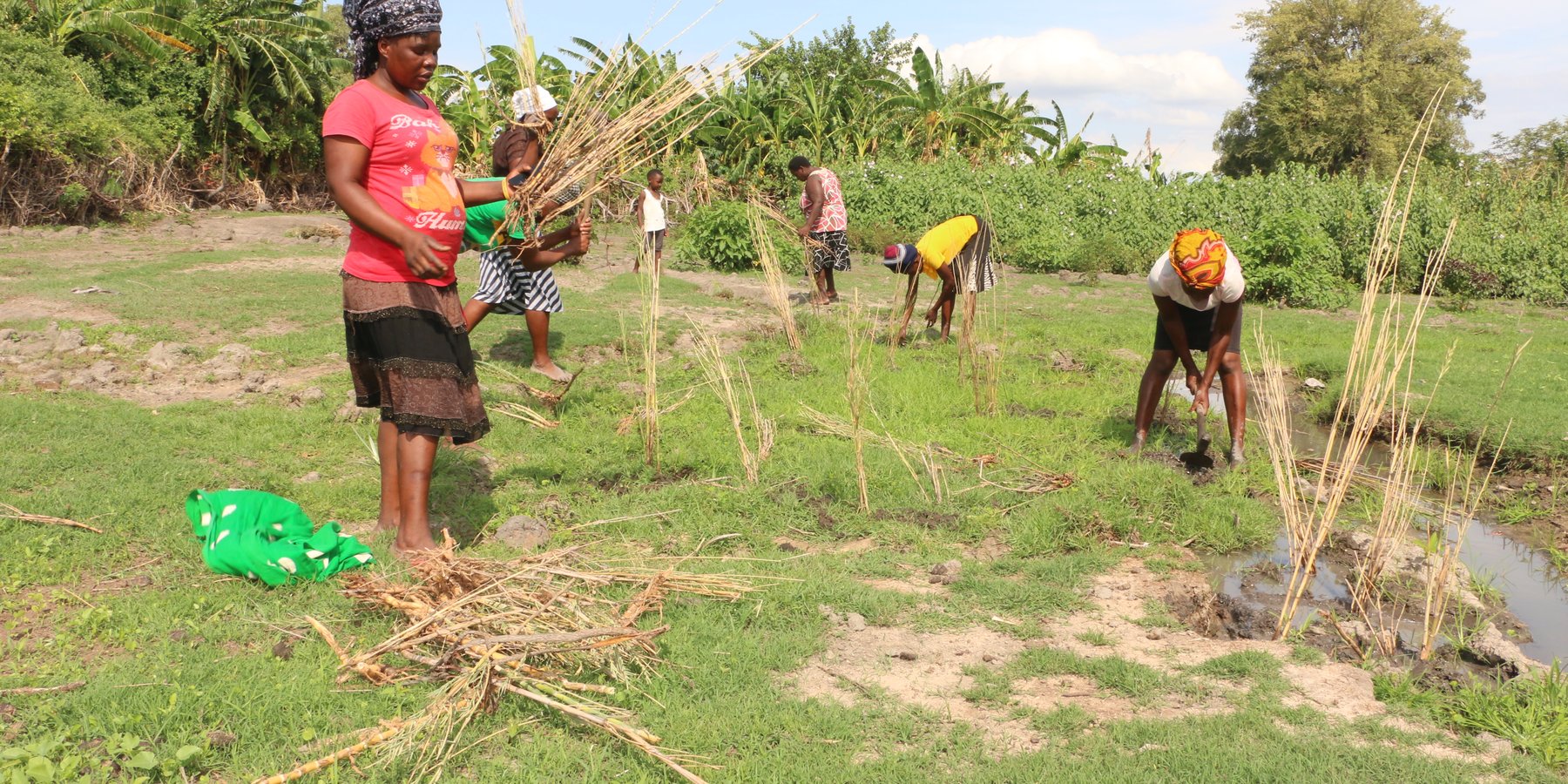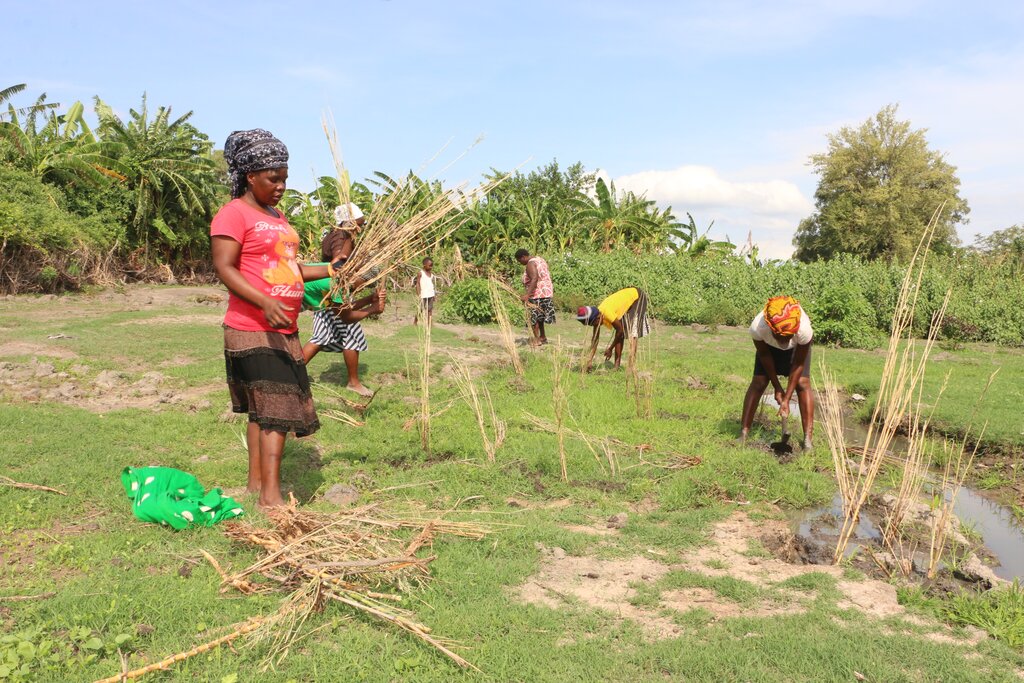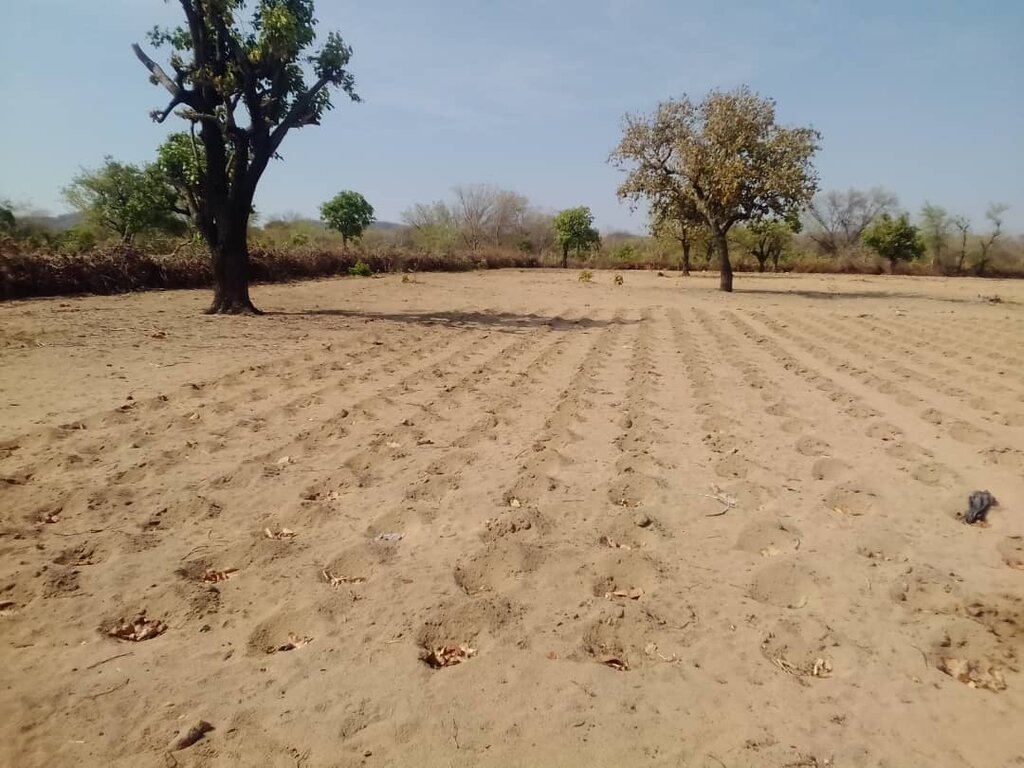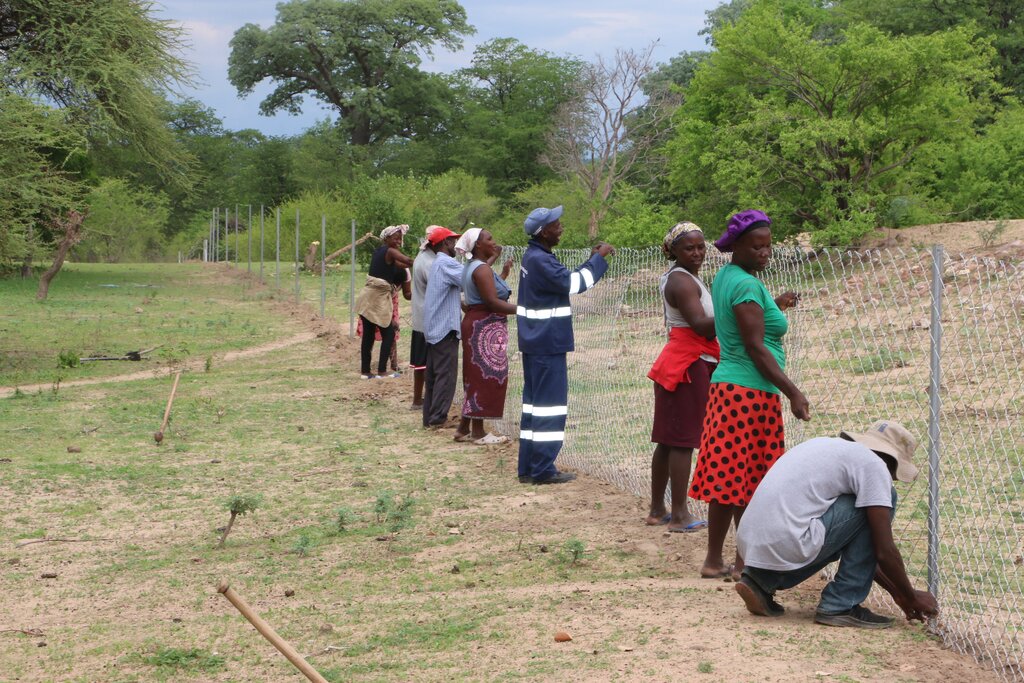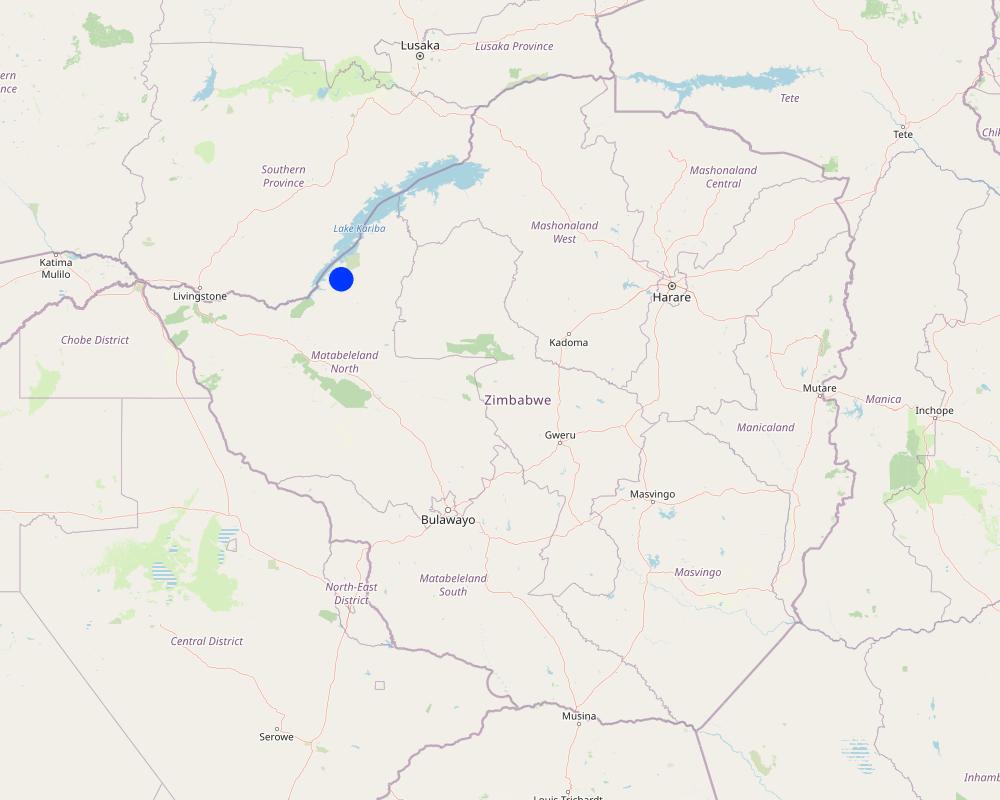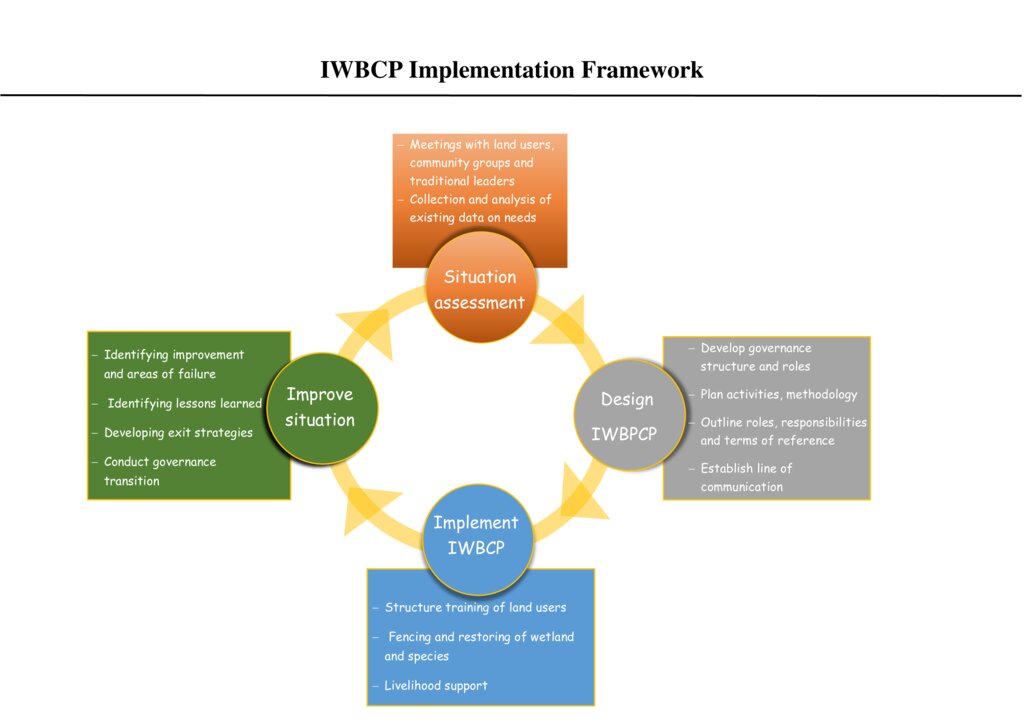Integrated Wetlands Biodiversity Conservation Project [Zimbabwe]
- Création :
- Mise à jour :
- Compilateur : Kalulu Mumpande
- Rédacteur : –
- Examinateurs : William Critchley, Joana Eichenberger
IWBCP
approaches_7367 - Zimbabwe
Voir les sections
Développer tout Réduire tout1. Informations générales
1.2 Coordonnées des personnes-ressources et des institutions impliquées dans l'évaluation et la documentation de l'Approche
Personne(s) ressource(s) clé(s)
co-compiler:
Mumpande Kalulu
+263773667529 / +263773667529
mumpandekalulu@yahoo.com / safesewa@gmail.com
Safe Environment & Wildlife Africa
Stand No. 1659 Medium Density Binga
Zimbabwe
Spécialiste GDT:
Mumkombwe Jane
+263 773666246 / +263 773666246
katemunkombwe46@gmail.com / katemunkombwe46@gmail.com
Agriculture & Rural Development Advisory Services (ARDAS)
Binga medium Density Stand no// 872 Binga
Zimbabwe
exploitant des terres:
Susan Mwembe
+263782644815 / +263782644815
Nil / Nil
Smallholder Farmer
Manjolo Primary School P.O Box 10 Binga
Zimbabwe
exploitant des terres:
Mudenda Naison
+263771152184 / +263771152184
Nil / Nil
Smallholder Farmer
Manjolo Primary School P.O Box 10 Binga
Zimbabwe
Indigenous Knowledge Guardian:
Mwembe Nomai
+263775256810 (Daughter) / +263775256810 (Daughter)
Nil / Nil
Community Elderly
Manjolo Primary School P.O Box 10 Binga
Zimbabwe
Nom du ou des institutions qui ont facilité la documentation/ l'évaluation de l'Approche (si pertinent)
Safe Environment & Wildlife Africa (SEWA)1.3 Conditions relatives à l'utilisation par WOCAT des données documentées
Quand les données ont-elles été compilées (sur le terrain)?
21/10/2024
Le compilateur et la(les) personne(s) ressource(s) acceptent les conditions relatives à l'utilisation par WOCAT des données documentées:
Oui
2. Description de l'Approche de GDT
2.1 Courte description de l'Approche
The integrated wetlands biodiversity conservation project aims to restore wetlands and associated biodiversity. The approach strengthens the resilience of neighbouring marginalized groups to climate change through developing lifelong skills and providing livelihoods support.
2.2 Description détaillée de l'Approche
Description détaillée de l'Approche:
The Integrated Wetlands Biodiversity Conservation Project aims to restore wetlands and associated biodiversity. It is a 2-year project which started in June 2023 with the support of a USD 50,000.00 grant from the Global Environment Facility Small Grants Programme, implemented by the United Nations Development Programme (UNDP-GEFSGP). The approach strengthens the resilience of neighbouring community to climate change through developing lifelong skills and providing livelihood support. It targets those marginalized groups surrounding protected areas, who experience severe droughts due to high cases of human-wildlife conflicts, making them highly food insecure. The approach is simultaneously improving sustainable management and utilization of the Masibinta wetland and its catchment.
Technical activities are targeted at restoring Masibinta wetland’s ecological integrity by protecting the wetland, implementing conservation agriculture in its catchment, reforesting bare land, controlling and reshaping gullies to create small ponds, and removing a bushy invasive species (Ipomoea carnea) while making compost from its leaves and branches. The ponds increase the recharge of the wetland. This helps provide water to the community and at the same time acts as a barrier to soil erosion and epicenters for natural vegetative cover regeneration and biodiversity restoration. Land degradation neutrality is an overall goal.
Specific targets include:
(a) Protection, rehabilitation and conservation of 13 hectares of Masibinta wetlands, as well as reclamation of degraded land in and around the wetland, while increasing the capacity of the community members to conserve biodiversity.
(b) Increasing access of 387 households to adequate and clean water.
(c) Reduction of invasive species in the wetlands by 80%, and reclamation of 1000 m of gullies.
(d) Promotion of sustainable use and management of Masibinta wetland through regenerative agriculture, livelihood support and imparting lifelong skills to 50 youths (30 females and 20 males).
A variety of technical and social methods are employed:
(a) Grey and Green Infrastructure (GGI): hybrid restoration techniques that involve the combination of engineered structures and Nature-based Solutions (NbS).
(b) Regenerative agriculture: including mulching, mixed cultivation, crop rotation, agroforestry, use of organic manure in nutrition gardens, and zero tillage (“Maganko”).
(c) Incentives: monetary incentives to the community members who offer their labour.
(d) Self-mobilization.
(e) Peer-to-peer learning.
(f) Problem-solving.
The stages of implementation involved are:
(a) Baseline survey,
(b) Education and training of project support staff, stakeholders,
(c) Monitoring, Evaluation and Learning (MEL),
(d) Livelihood support,
(e) Protection of the wetland, then MEL,
(f) Borehole Drilling,
(g) Invasive species management, then MEL,
(h) Gully modification, and
(i) Evaluation and Learning.
The stakeholders involved and their roles are:
(a) Environmental Management Agency (EMA): Implement and monitor restoration activities in the wetland and assess the impact of barricading the gully on the environment.
(b) Forestry Commission (FC): Nursery establishment, management and tree planting.
(c) Agriculture and Rural Advisory Services (ARDAS): Train farmers on agroforestry, goat rearing, climate-smart agriculture, gully reclamation, and polyculture.
(d) Rural and Infrastructure Development Agency (RIDA): oversees all engineering work.
(e) Ministry of Youth Empowerment Development and Vocational Training (MYEDVT): Monitoring youth engagement and benefits.
(f) Ministry of Women Affairs Community Small and Medium Enterprises Development (MWACSMED): Tracked and monitored inclusion and entrepreneurship.
(h) United Nations Development Programme – Grant disbursement, monitoring and evaluating the implementation and sustainability of IWBCP at the national level in line with the GEFSGP expectations.
2.3 Photos de l'approche
2.4 Vidéos de l'Approche
Date:
02/02/2024
Lieu:
Manjolo
Nom du vidéaste:
Kalulu Mumpande
2.5 Pays/ région/ lieux où l'Approche a été appliquée
Pays:
Zimbabwe
Région/ Etat/ Province:
Matebeleland North
Autres spécifications du lieu :
Binga
Commentaires:
Masibinta wetland, surrounded by bare catchment areas
Map
×2.6 Dates de début et de fin de l'Approche
Indiquez l'année de démarrage:
2023
Si l'année précise est inconnue, indiquez approximativement quand l'Approche a démarré:
il y a moins de 10 ans (récemment)
Date (année) de fin de l'Approche (si l'Approche n'est plus appliquée):
2025
2.7 Type d'Approche
- fondé sur un projet/ programme
2.8 Principaux objectifs de l'Approche
The Approach aimed at developing an environmentally responsive community, capable of managing and utilizing Masibinta Wetland most sustainably through:
(a)Increasing knowledge and skills in restoring degraded and conserving the restored land
(b)Improving perceptions on biodiversity and building best practices which promote sustainability of the natural resources capital
(c)Increasing conservation benefit sharing and improving governance of the natural resources
2.9 Conditions favorisant ou entravant la mise en œuvre de la(des) Technologie(s) appliquée(s) sous l'Approche
collaboration/ coordination des acteurs
- favorise
Collaboration between the stakeholder and the community enabled the Approach to win a Provincial Award: Excellence in Biodiversity Restoration and Social Impact.
cadre juridique (régime foncier, droits d'utilisation des terres et de l'eau)
- entrave
Land is owned along family lines which make it difficult to restore. For example a 100-meters portion of a gully which was reclaimed was later cleared to paved a way for a garden by the family member.
cadre politique
- entrave
Lack of policy on conservation cultivation
connaissances sur la GDT, accès aux supports techniques
- entrave
The stakeholders have limited knowledge on disaster risk reduction and regenerative farming
marchés (pour acheter les intrants, vendre les produits) et prix
- entrave
Limited access to markets which offers competitive prices for the landers as producers.
charge de travail, disponibilité de la main-d'œuvre
- entrave
The work load is huge and the manpower is limited. The support staff were on a voluntary contract.
3. Participation et rôles des parties prenantes impliquées dans l'Approche
3.1 Parties prenantes impliquées dans l'Approche et rôles
- exploitants locaux des terres / communautés locales
Traditional leaders and community members
Community members provided labour and security of materials and food during the Approach's activities. They also monitored and evaluated the Approach and provided valuable lessons. Traditional leadership provided the approach's local oversight role, whipped members into line, provided Indigenous knowledge, and guided the implementation process in accordance with the values and beliefs of the Manjolo community. Traditional leadership was key in information dissemination and resolution of issues which would otherwise affect the success of the Approach
- Spécialistes de la GDT/ conseillers agricoles
Agriculture & Rural Development Advisory Services (ARDAS), ZimParks, Forest Commission, Environmental Management Agency (EMA), Small to Medium Enterprises, Ministry of Youth, Social Development, Ministry of Information, Ministry of Health and Child Welfare
Provided technical support, training community members, and local management committees. Supervising activities and evaluating the Approach
- gouvernement local
Binga District Development Committee
Monitoring and Evaluation of the Approach
Providing supportive framework and ensuring that the Approach keep in line with the district's development agenda
Si plusieurs parties prenantes sont impliquées, indiquez l'organisme chef de file ou l'institution responsable:
Environment Management Agency (EMA) and Agriculture & Rural Development Advisory Services (ARDAS)
3.2 Participation des exploitants locaux des terres/ communautés locales aux différentes phases de l'Approche
| Participation des exploitants locaux des terres/ communautés locales | Spécifiez qui était impliqué et décrivez les activités | |
|---|---|---|
| initiation/ motivation | auto-mobilisation | Smallholder farmers The initiation began in October 2022 where the organized a meeting and invited SEWA. At this meeting the farmer highlighted the degradation of Masibinta wetland and how the degradation was negatively affecting their lives. The farmers gave suggestion on possible solutions to the challenges faced. |
| planification | interactive | Smallholder farmers, youth, traditional leaders, local business community, church leaders, teachers, Rural Care Givers, Health Workers, Resources Monitors, Counsellors, People with Disability In December 2022, the farmers who initiated the Approach mobilized community members to a planning meetings, developed activities, pledged own contribution to the Approach, outlined roles of each social group in the Approach, developed ways of mobilizing locally available materials and selected management committees and local lines of communication. They also identified potential challenges and suggested ways of dealing with the challenges that could otherwise arise from the Approach |
| mise en œuvre | interactive | The smallholder farmers, traditional leaders, local business community, youth, church leaders, teachers, Rural Care Givers, Health Workers, Resources Monitors, Counsellors, People with Disability The implementation started in July 2023 after GEFSGP had supported the Approach with a grant of $50,000.00 through the UNDP. The community members worked together and provided labour and security of materials and food during the Approach's activities. They also monitored and evaluated the Approach and provided valuable lessons. Traditional leadership provided the approach's local oversight role, whipped members into line, provided Indigenous knowledge, and guided the implementation process in accordance with the values and beliefs of the Manjolo community. Traditional leadership was key in information dissemination and resolution of issues which would otherwise affect the success of the Approach |
| suivi/ évaluation | interactive | Small holder farmers, youth, traditional leaders, local business community, church leaders, teachers, Rural Care Givers, Health Workers, Resources Monitors, Counsellors, and People with Disability, These provided the views on how the Approach impacted their lives and also on what needed to be changed. |
3.3 Diagramme/ organigramme (si disponible)
Description:
Integrated Wetland Biodiversity Conservation Project (IWBCP) Implementation framework
Auteur:
Mumpande Kalulu
3.4 Prises de décision pour la sélection de la Technologie/ des Technologies
Indiquez qui a décidé de la sélection de la Technologie/ des Technologies à mettre en œuvre:
- tous les acteurs concernés dans le cadre d'une approche participative
Spécifiez sur quelle base ont été prises les décisions:
- expériences et opinions personnelles (non documentées)
4. Soutien technique, renforcement des capacités et gestion des connaissances
4.1 Renforcement des capacités/ formation
Une formation a-t-elle été dispensée aux exploitants des terres/ autres parties prenantes?
Oui
Si pertinent, spécifiez le genre, l'âge, le statut, l'ethnie, etc.
124 smallholder farmers (69 females, 55 males), 10 Village Heads (2 females, 11males), and 2 Ward-based Environment Monitors (all males) were capacity developed from the 32 hours structured training on land and biodiversity restoration and conservation. During the training the participants were engaged through presentations, drama, role plays, scenarios, problem-solving and field trips. The key stakeholders drawn from government line ministries, and Binga Rural District Council trained the the beneficiaries.
Formats de la formation:
- sur le tas
- entre agriculteurs (d'exploitants à exploitants)
- réunions publiques
Thèmes abordés:
Biodiversity conservation, project infrastructure management, sustainable land management, agroforestry, gully reclamation, conservation farming, climate change, and environmental policies
Commentaires:
The training sessions were not enough due to limited budget. Each training was conducted conducted over for 8hrs and the participants had little time for hands-on participation.
4.2 Service de conseils
Les exploitants des terres ont-ils accès à un service de conseils?
Oui
Spécifiez si le service de conseils est fourni:
- dans les champs des exploitants?
- dans des centres permanents
Décrivez/ commentez:
The Rural & Infrastrure Development Agency , Forest Commission and Agriculture & Rural Development Advisory Services provided advisory services to land users crop fields preparation, gully reclamation, tree planting, and wetland management
4.3 Renforcement des institutions (développement organisationnel)
Des institutions ont elles été mises en place ou renforcées par le biais de l'Approche?
- oui, modérément
Spécifiez à quel(s) niveau(x), ces institutions ont été renforcées ou mises en place:
- local
Décrivez l'institution, ses rôles et responsabilités, ses membres, etc.
Community Management Committee and local constitution
Supervision of the land users and enforcing constitution
Précisez le type de soutien:
- renforcement des capacités/ formation
Donnez plus de détails:
The management committee was trained once on their roles. However, more structured training would enhance their discharge of duties
4.4 Suivi et évaluation
Le suivi et l'évaluation font ils partie de l'Approche? :
Oui
Commentaires:
Continuous monitoring was carried out by the Approach support staff. Monitoring and Evaluation was done quarterly, involving all key stakeholders
Si oui, ce document est-il destiné à être utilisé pour le suivi et l'évaluation?
Non
4.5 Recherche
La recherche a-t-elle fait partie intégrante de l’Approche?
Non
5. Financement et soutien matériel externe
5.1 Budget annuel de la composante GDT de l'Approche
Indiquez le budget annuel de la composante GDT de l'Approche en $ US:
25000,00
Commentez (par ex. principales sources de financement/ principaux bailleurs de fonds):
-Co-funding
-Global Environment Facility Small Grants Programme, implemented by the United Nations Development Programme (UNDP_GEFSGP)
5.2 Soutiens financiers/ matériels fournis aux exploitants des terres
Les exploitants des terres ont-ils reçu un soutien financier/ matériel pour la mise en œuvre de la Technologie/ des Technologies?
Oui
Si oui, spécifiez le(s) type(s) de soutien, les conditions et les fournisseurs:
Fencing materials, stationary, cement, goats, seed inputs
Provider: UNDP_GEFSGP
5.3 Subventions pour des intrants spécifiques (incluant la main d'œuvre)
- équipement
| Spécifiez les intrants subventionnés | Dans quelle mesure | Spécifiez les subventions |
|---|---|---|
| outils | en partie financé | |
| Fencing material | entièrement financé | |
- intrants agricoles
| Spécifiez les intrants subventionnés | Dans quelle mesure | Spécifiez les subventions |
|---|---|---|
| semences | en partie financé | |
- infrastructures
| Spécifiez les intrants subventionnés | Dans quelle mesure | Spécifiez les subventions |
|---|---|---|
| Fence | entièrement financé | |
Si la main d'œuvre fournie par les exploitants des terres était un intrant substantiel, elle était:
- volontaire
Commentaires:
The land user provided voluntary work during the fencing of the wetland. An additional funding of $15,000.00 for the management of the Ipomoea carnea and gully medication has been secured from he G20 Global Land Restoration Initiative. Under these activities, the land users will be provided and an incentive of $1.50 per day per individual for the provision of labour. The activities are yet to be implemented once the funds are disbursement into SEWA's bank account.
5.4 Crédits
Des crédits ont-ils été alloués à travers l'Approche pour les activités de GDT?
Non
5.5 Autres incitations ou instruments
D'autres incitations ou instruments ont-ils été utilisés pour promouvoir la mise en œuvre des Technologies de GDT?
Oui
Si oui, spécifiez:
Monetary incentive (for activities which are yet to be done using the additional support from the G20 Global Land Restoration Initiative)
6. Analyses d'impact et conclusions
6.1 Impacts de l'Approche
Est-ce que l'Approche a autonomisé les exploitants locaux des terres, amélioré la participation des parties prenantes?
- Non
- Oui, un peu
- Oui, modérément
- Oui, beaucoup
124 land users were trained, supported with seed imputes, and goats.
Est-ce que l'Approche a permis la prise de décisions fondées sur des données probantes?
- Non
- Oui, un peu
- Oui, modérément
- Oui, beaucoup
Decisions were made based on data gathered from community engagements, lessons learned from the before projects in the area and the surveys conducted as a baseline.
Est-ce que l'Approche a aidé les exploitants des terres à mettre en œuvre et entretenir les Technologies de GDT?
- Non
- Oui, un peu
- Oui, modérément
- Oui, beaucoup
Land users have reclaimed 100 metres of gullies, implemented conservation cultivation, used nature-based approaches to restore the wetland
Est-ce que l'Approche a amélioré la coordination et la mise en œuvre de la GDT selon un bon rapport coût-efficacité?
- Non
- Oui, un peu
- Oui, modérément
- Oui, beaucoup
The use of Nature-based Solutions and indigenous knowledge reduced the cost of implementing the SLM as such approaches are cheaper in terms of cost. Approach improved coordination between the project management and land users through clearly defined roles and lines of communication
Est-ce que l'Approche a mobilisé/ amélioré l'accès aux ressources financières pour la mise en œuvre de la GDT?
- Non
- Oui, un peu
- Oui, modérément
- Oui, beaucoup
Mobilized finances from the Global Environment Facility Small Grants Programme through the United Nations Development Programme (UNDP-GEFSGP). Finances have also been mobilized from the G20 Global Land Initiative, though yet to be disbursed into SEWA's bank account.
Est-ce que l'Approche a amélioré les connaissances et les capacités des exploitants des terres pour mettre en œuvre la GDT?
- Non
- Oui, un peu
- Oui, modérément
- Oui, beaucoup
124 land users were trained on SLM and were given kowledge material such as brochures.
Est-ce que l'Approche a amélioré les connaissances et les capacités des autres parties prenantes?
- Non
- Oui, un peu
- Oui, modérément
- Oui, beaucoup
Not much training of stakeholders was done. However the stakeholders drew lessons from the project and shared their experience during project progress update meetings.
Est-ce que l'Approche a construit/ renforcé les institutions, la collaboration entre parties prenantes?
- Non
- Oui, un peu
- Oui, modérément
- Oui, beaucoup
Each and every stakeholder involved in the project had clearly defined roles and synergies
Est-ce que l'Approche a atténué les conflits?
- Non
- Oui, un peu
- Oui, modérément
- Oui, beaucoup
The fencing of wetland including the nutrition gardens and the development of the land users' constitution mitigated conflicts
Est-ce que l'Approche a autonomisé les groupes socialement et économiquement défavorisés?
- Non
- Oui, un peu
- Oui, modérément
- Oui, beaucoup
Assisted women, youth and people with disability with female goats. These groups were trained under the same rood
Est-ce que l'Approche a encouragé les jeunes/ la prochaine génération d'exploitants des terres à s'engager dans la GDT?
- Non
- Oui, un peu
- Oui, modérément
- Oui, beaucoup
Financial limitation reduced the engagement of youth in Manjolo as the effective method of engaging youth in Manjolo require a reasonable budget
Est-ce que l'Approche a amélioré les questions foncières et des droits d'utilisation qui entravent la mise en œuvre des Technologies?
- Non
- Oui, un peu
- Oui, modérément
- Oui, beaucoup
The Approach has not yet tackled the issue
Est-ce que l'Approche a conduit à améliorer la sécurité alimentaire et/ou la nutrition?
- Non
- Oui, un peu
- Oui, modérément
- Oui, beaucoup
Through crop yields, and income generation projects.
Est-ce que l'Approche a amélioré l'accès aux marchés?
- Non
- Oui, un peu
- Oui, modérément
- Oui, beaucoup
Local market. Land users are supply Boarding School and a hospital with green vegetables
Est-ce que l'Approche a conduit à améliorer l'accès à l'eau et l'assainissement?
- Non
- Oui, un peu
- Oui, modérément
- Oui, beaucoup
Boreholes Drilling couldn't find water.
Est-ce que l'Approche a conduit à l'utilisation/ sources d'énergie plus durables?
- Non
- Oui, un peu
- Oui, modérément
- Oui, beaucoup
The Approach did not look at energy
Est-ce que l'Approche a amélioré la capacité des exploitants des terres à s'adapter aux changements/ extrêmes climatiques et a atténué les catastrophes liées au climat?
- Non
- Oui, un peu
- Oui, modérément
- Oui, beaucoup
Through training and livelihoods support
2 youth were employed for fencing
6.2 Principale motivation des exploitants des terres pour mettre en œuvre la GDT
- augmenter la production
Improved protection of their crops in nutrition gardens, increased crop production, ownership and management of the wetland.
- augmenter la rentabilité/ bénéfice, rapport coûts-bénéfices
81 out of 144 wetland users reported an average increase of 32% from their incomes over the last cropping season. 79 out of 144 reported an average increase of 40 kg of maize production in the last between November 2023 and March 2024. All wetland user reported reduced destruction of their crops by livestock over the past cropping season.
- réduire la dégradation des terres
67 Farmers adopted the use of organic fertilizers and 23 were involved in the demo plots for poly cropping. The wetland user protected 13 seeps using the reeds. 15 farmers have since abandoned the use of brash wood fencing adopting the edible hedging. These practices have reduced land degradation. However restoration is still ongoing to realize full impact of the Approach.
- réduire les risques de catastrophe
89 out 144 households which used to miss at least a meal per day during the drought months (July to February) reported that they never missed a meal between July 2024 and October 2024.
- réduire la charge de travail
The fencing of wetland has significantly reduced the workload particularly for women and girls who used to spend about 27% of their 24-Hour Day manning their gardens from animals. A 12% decrease in time spend looking after crops has been observed.
- règles et règlements (amendes)/ application
As way of improving sustainability of Masibinta wetland, the community have set rule and regulations for the management of the resources. The trespassers are liable to a commensurate fines and the rules are enforces at local level by the Community Management Committee (CMC) and the traditional leadership. The community members participate in the enforcement of the rules through being own police.
- prestige, pression sociale/ cohésion sociale
Masibinta Wetland saves support 2400 community members and 3 schools with water, livelihoods and income for feeds and health needs. The restoration of the wetland by the Approach has unified different groups in the community by working and living together for a common cause. It has improved social relationships, pride and reduced poverty
- affiliation à un mouvement/ projet/ groupe/ réseaux
As a result of the Approach, SEWA has joined the UNCCD and WOCAT Network.
- conscience environnementale
The Land Users have formed the Manjolo Environment Defenders Club (MEDC). The MEDC was formed as community initiative led by women after being educated by the Approach on land restoration and Protection. The club carries out peer-to -peer education on best environmental practices, such as encouraging fellow Land Users to use organic fertilizers, stop cutting of trees, accouraging safe use of wetland and monitoring the wetland health. The club started with 4 women but now the membership has grown to 15. This shows improved environmental consciousness as a result of the Approach
- coutumes et croyances, morale
The Approach has improved the Land Users' awareness of the importance of conserving land resources. This motivated them to explore beyond what they were taught. They now value nature more that before the implementation of the approach.
- améliorer les connaissances et compétences en GDT
The training reconceived by the Land Users has equipped them with skills to contract gabions, plants trees, raise tree nurseries for commercial purpose. Two of the youth who were trained in fence installation got contracts on fencing. The farmers who were trained on regenerative agriculture, are now practicing on their crop fields.
- améliorer l'esthétique
The Approach's innovativeness and novelty made to appeal o the Land Users
- atténuer les conflits
Conflicts caused by livestock destroying crops in nutritional gardens have been reduced. However due to the improved habitat conditions, crocodiles and pythons have since invaded the wetland and new conflicts have arisen between these species and the farmers. How, SEWA is working with the Community Resources, Communal Areas Management Programmes For Indigenous Resources (CAMPFIRE) and Zimbabwe Parks & Wildlife Management Authority (ZimParks) in monitoring and relocating the crocodiles and pythons.
6.3 Durabilité des activités de l'Approche
Les exploitants des terres peuvent-ils poursuivre ce qui a été mis en œuvre par le biais de l'Approche (sans soutien extérieur)?
- oui
Si oui, décrivez de quelle manière:
In terms of human sustainability, the training that the Land Users have received, skills and knowledge that they have gained will enable them to continue with the project activities without any external support. The involvement of the Land Users in decision making structures and programmes will enable Land Users to make and implement key decisions beyond the external support. The income generating projects and the Internal Savings and Lending Schemes introduced under the Approach will ensure financial sustainability. The training of the stakeholders by the Approach provide the technical sustainability.
6.4 Points forts/ avantages de l'Approche
| Points forts/ avantages/ possibilités du point de vue de l'exploitant des terres |
|---|
| The Approach is providing women with financial independence and choices. |
| The Approach is empowering the marginalized community groups with climate resilient and bankable assets. For example 12 youth, 3 people with disability and 10 women have been assisted with 2 female goats, increasing conservation benefits. |
| The land Users view the Approach as their out of hunger and poverty |
| Points forts/ avantages/ possibilités du point de vue du compilateur ou d'une autre personne ressource clé |
|---|
| Views the Approach as sustaible and transformative development. |
| The Approach is viewed as practical demonstration of sustainable land management |
| Viewed as a sources of lessons for the partners and environmentalists |
6.5 Faiblesses/ inconvénients de l'Approche et moyens de les surmonter
| Faiblesses/ inconvénients/ risques du point de vue de l’exploitant des terres | Comment peuvent-ils être surmontés? |
|---|---|
| The Approach has a limited thrust on influencing policy and land tenure | Involving policy makers at local level |
| The Approach has not identified learning areas | Identify learning areas through monitoring and evaluation sessions |
| Faiblesses/ inconvénients/ risques du point de vue du compilateur ou d'une autre personne ressource clé | Comment peuvent-ils être surmontés? |
|---|---|
| The ponds may cause risk of drowning of children as kids love playing in water | Constructing shallow ponds |
7. Références et liens
7.1 Méthodes/ sources d'information
- visites de terrain, enquêtes sur le terrain
24
- interviews/entretiens avec les exploitants des terres
6
- interviews/ entretiens avec les spécialistes/ experts de GDT
1
7.2 Références des publications disponibles
Titre, auteur, année, ISBN:
None
7.3 Liens vers les informations pertinentes disponibles en ligne
Titre/ description:
None
Liens et modules
Développer tout Réduire toutLiens
Aucun lien
Modules
Aucun module trouvé


